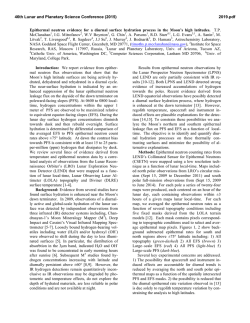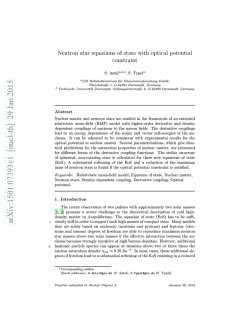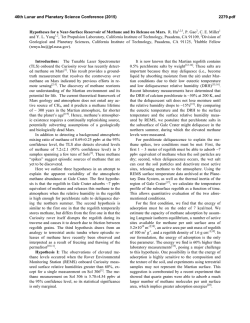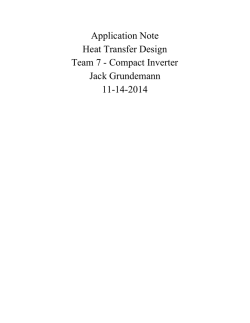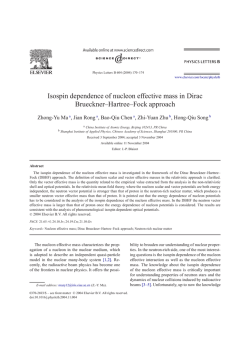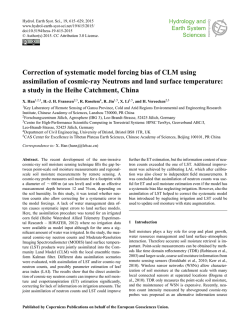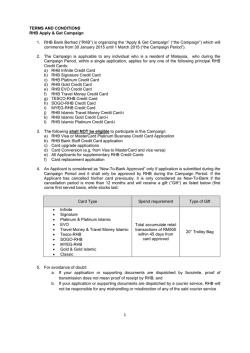
2145
46th Lunar and Planetary Science Conference (2015) 2145.pdf THERMAL CONDUCTIVITY OF THE NEAR-SURFACE MARTIAN REGOLITH DERIVED FROM VARIATIONS IN MSL PASSIVE NEUTRON COUNTS AND GROUND TEMPERATURE MEASUREMENTS. C. G. Tate1, J. Moersch1,2, I. Jun3, C. Hardgrove2, M. Mischna3, M. Litvak4, A. Varenikov4, I. Mitrofanov4, W.V. Boynton5, L. Deflores3, D. Drake6, F. Fedosov4, D. Golovin4, K. Harshman5, A.S. Kozyrev4, D. Lisov4, A. Malakhov4, R. Milliken7, M. Mokrousov4, S. Nikiforov4, A.B. Sanin4, R. Starr8, A. Vostrukhin4, F. J. Martin-Torres9, 10, María-Paz Zorzano11. 1Dept. Of Physics & Astronomy, University of Tennessee, Knoxville, TN, USA, [email protected], 2Dept. Of Earth & Planetary Sciences, University of Tennessee, Knoxville, TN, USA, 3Jet Propulsion Laboratory/California Institute of Technology, Pasadena, CA, USA, 4Space Research Institute, RAS, Moscow, Russia, 5 University of Arizona, Tucson, AZ, USA, 6TechSource, Inc, Los Alamos, NM, USA, 7Brown University, Providence, RI, USA, 8NASA Goddard Space Flight Center, Greenbelt, MD, USA, 9Instituto Andaluz de Ciencias de la Tierra, Granada, Spain, 10Division of Space Technology, Department of Computer Science, Electrical and Space Engineering, Luleå University of Technology, Kiruna, Sweden, 11 Centro de Astrobiología, Madrid, Spain. Introduction: The Dynamic Albedo of Neutrons experiment (DAN) on the Mars Science Laboratory (MSL) rover Curiosity is designed to detect neutrons for the purpose of sensing hydrogen within the subsurface of Mars [1]. DAN is capable of detecting neutrons through the use of two 3He proportional counters, one unshielded and the other shielded with cadmium (Cd), which blocks neutrons with energies below ~0.4 eV [1] from being counted. This work will focus exclusively on the instrument's passive mode of operation. Neutrons detected by DAN in passive mode, are generated by galactic cosmic rays (GCR) spallating neutrons through interactions with the constituents of the atmosphere and regolith and the MSL Multi-Mission Radioisotope Thermoelectric Generator (MMRTG) producing neutrons through the decay of 238Pu. The entire neutron population, once created, will then move throughout the subsurface and interact with the constituents of the regolith. Inelastic and elastic scattering, specifically, will have the effect of moderating the energies of these neutrons [2]. These interactions gives rise to a neutron leakage flux from the surface that the DAN 3He proportional counters can measure. The energy spectrum of these neutrons is directly dependent on the amount of hydrogen in the subsurface. A higher hydrogen content will lead to more moderation and thus more low energy (thermalized) neutrons. The local environment, however, may also have an effect on this spectrum. In investigating effects due to the local environment, data from the Rover Environmental Monitoring Station (REMS) has been used. Among other variables, REMS measures the local atmospheric pressure and the ground surface temperature near the rover [4]. The ground temperature sensor, specifically, is an infrared detector, that allows the retrieval of the effective temperature from the top few tens of microns of the surface [4]. The purpose of the work presented here is to simulate the effect of subsurface temperatures and atmospheric pressure on the DAN passive measurements and use this to estimate the bulk thermal conductivity of the Martian regolith (discussed in the Methods section below) at certain locations where enough DAN passive data have been collected to observe the diurnal variations. Diurnal Variations: DAN passive data have been taken at many locations and local times throughout the mission so far. At sites where the data acquired over many sols cover a large portion of the diurnal cycle, variations in the thermal and corresponding epithermal neutron count rates were observed to correlate with the local time of the day [5]. These locations were Rocknest (sols 59-100) and John Klein (sols 166-272). Figure 1 shows the data accumulated at Rocknest over this time period. Fig. 1. DAN passive measurements of thermal neutron count rates at Rocknest. Overlaid is REMS average ground temperature data from the same location. The population of epithermal neutrons as a function of local time is anticorrelated with the thermal neutron population, which is expected, as it is epithermal neutrons that are being moderated into the thermal neutron population. A time delay between the peak in the thermal neutron counts per second and the surface temperature is also observed. The data from these locations were analyzed using Fourier transform methods to better understand the periodicity. Both locations exhibited a 1-sol period within the data. For example, the corresponding power spectral density for Rocknest is shown in Figure 2; analogous data from John Klein are very similar. 46th Lunar and Planetary Science Conference (2015) Fig. 2. Power spectral density of Rocknest DAN passive data showing an unambiguous 1-sol periodicity. Previous work has explored the plausibility that these diurnal variations are being driven by subsurface temperature and/or atmospheric pressure variations [5]. Specifically, ground temperature can affect the thermalized neutron population because the temperature of a moderating medium affects the amount of thermalization, causing the Maxwellian distribution of the neutron population’s energy to shift more of its high-energy tail past the ~0.4 eV Cd cutoff at higher ground temperatures. This means that a higher temperature regolith leads to lower thermal neutron counts (all other things being equal). The observed time delay is due to the fact that the neutron population is sensitive to a weighted average of the temperature at depth, rather than the surface temperature, and temperatures at depth experience phase lags relative to the surface [5]. Using this as a starting point, we hypothesize that the bulk thermal conductivity of the regolith at Rocknest and John Klein can be determined with the method described below. Methods: We use the Monte Carlo Neutral ParticleExtended (MCNPX) software package [6], which models the transport and interactions of Galactic Cosmic Rays (GCR) protons and the neutrons they produce, to model the effects of diurnal variations in atmospheric pressure and regolith temperature on the neutron energy spectrum. The model consists of multiple simulations that contain different neutron sources. Previous models of the Martian atmosphere and particle transport [5,7] are used as source inputs for a local-scale model to estimate the GCR-induced neutron leakage flux. These simulations include a MSL rover mass model with the DAN detectors ~75 cm above the ground [1] to include the effects of the rover itself on the final neutron count rate. The last step is to model the contribution to the neutron-count rate from the MMRTG. This simulation has the same geometry as before, except that the neutron source is the MMRTG and neutrons are generated with a corresponding energy spectrum. The results from these steps are combined to get the thermal neutron count rate measured by DAN. Model inputs for regolith composition at Rocknest and John Klein have been determined previously [7, 8] and are used in modeling the respective sites. Atmospheric pressure and ground temperature inputs are varied to 2145.pdf examine their separate effects on the neutron count rates with values taken from REMS surface data [9]. Subsurface temperature profiles for different candidate thermal conductivities have been generated throughout the diurnal cycle by solving the thermal diffusion equation for a model regolith with the surface temperature from REMS data used as a boundary condition. This allows for different thermal conductivities to be simulated within the MCNPX models. Ultimately, this will allow for a small library of model results at different thermal conductivities to be compared to the data in order to determine the best match between data and model. This will be done through comparing the amplitude of variations in count rates and the time delay between these variations and the ground surface temperatures. To illustrate the method, one can think of combining idealized equations [10] for thermal inertia (Eq. 1) and thermal skin depth (Eq. 2) and then solving for thermal conductivity (Eq. 3). (1) In the above equations, is the thermal conductivity, is the density of the regolith, is the specific heat, is the rotational period of Mars, and is the thermal skin depth. In this method, thermal inertia will be taken from analyses of REMS GTS data [11], and the thermal skin depth will be determined through our modeling efforts. Interpretations/Conclusions: DAN passive measurements show diurnal variations that were previously attributed primarily to variations in subsurface temperature, and secondarily to variations in atmospheric pressure [5]. Analyses using the method described above will give better insight into the extent that the DAN passive measurements are affected and possibly allow for a determination of the bulk thermal conductivity of the martian regolith at these locations. Results of this study will be shown and discussed. References: [1] Litvak, et al. (2008) Astrobio., 8. [2 ] Drake, et al. (1988) Journal of Geophysical Research, 93. [3] Boynton, et al. (2004) Space Science Reviews, 110. [4] Gómez-Elvira, et al. (2012) Space Science Reviews 170. [5] Tate, et al. (2012) LPSC,1601. [6] McKinney. G.W. et al (2006), Los Alamos LA-UR-066206. [7] Tate, et al. (2014) Icarus, submitted. [8] Mitrofanov, et al. (2014) Journal of Geophysical Research Planets, online. [9] Harri, et al. (2014) Journal of Geophysical Research Planets, 119. [10] Turcotte and Schubert (2002) Geodynamics 2nd Ed., Cambridge University Press. [11] Hamilton, et al. (2014) LPSC, 1569.
© Copyright 2026
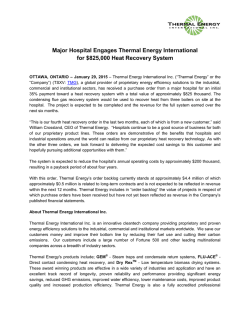
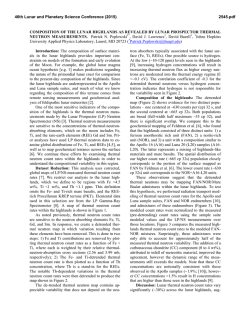

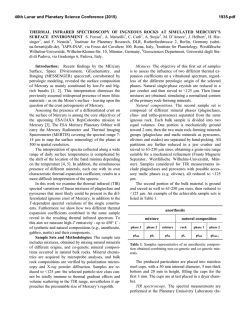
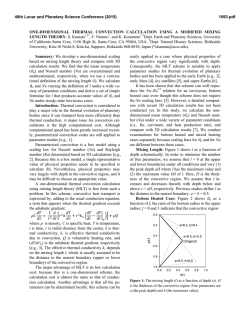
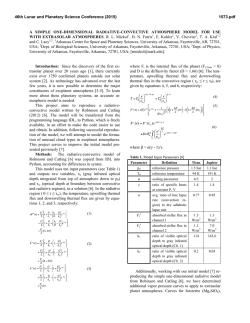
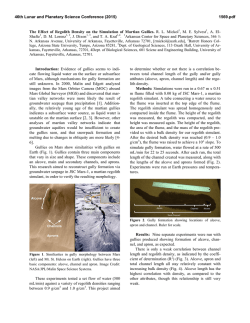
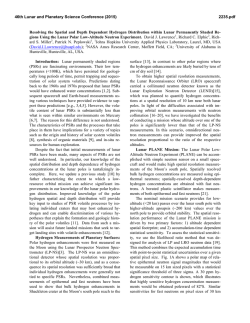
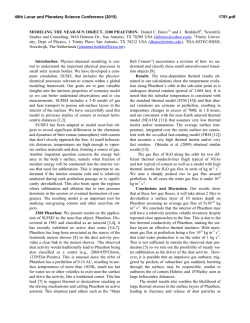
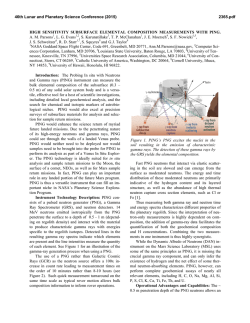

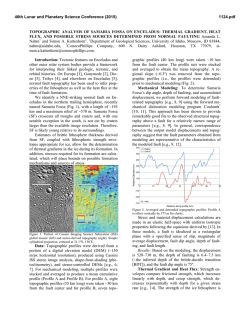
![Download the PDF [178 KB]](http://s2.esdocs.com/store/data/000499344_1-7f4373c1afe39f332b14a8d11d1a7c7f-250x500.png)
